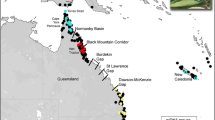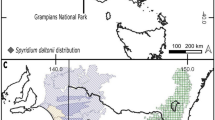Abstract
The relationship of two geographically and ecologically separated populations of Turraea socotrana Styles and F. White (Meliaceae), a vulnerable and scattered shrub from the island of Socotra (Yemen), was explored using preliminary molecular data. The nuclear ribosomal ITS region was used to screen the level of genetic divergence of T. socotrana from ecologically distant localities in comparison to a few other species of Turraea and closely related genera. The individuals from the inland (Diksam) differed from the western coastal ones (Ma’alah) by vegetative characters and by the rbcL gene. This may be due to the fact that the population from Ma’alah grows on lithosoil slopes directly exposed to moist winds coming from the sea, whereas the population of Diksam occurs on arid cliffs overlooking the inland of the island. The ITS sequences grouped the studied populations from Socotra together and separated them from other species of Turraea that are morphologically similar and occurring in East Africa. Considering the differences recorded in the rbcL gene, we suggest that the populations of T. socotrana investigated here on only a few specimens from two different areas on the island, deserve more research. Our preliminary study potentially indicates that there may be independent evolutionary significant units in this species, however, more research including a wider sampling and comparison to other taxa is needed.




Similar content being viewed by others
References
Banfield LM, Van Damme K, Miller AG (2011) Evolution and biogeography of the flora of the Socotra archipelago (Yemen). In: Bramwell D, Caujapé-Castells J (eds) The Biology of Island Floras. Edition. Cambridge University Press, Cambridge, pp 197–225
Benson DA, Cavanaugh M, Clark K et al (2013) GenBank. Nucleic Acids Res 41:D36–D42. https://doi.org/10.1093/nar/gks1195
Brown G, Mies BA (2012) Vegetation ecology of socotra, plant and vegetation 7. Springer, Dordrecht. https://doi.org/10.1007/978-94-007-4141-6_6
Bruni I, De Mattia F, Fluch S et al (2016) Genetic introgression of hybrid Rhododendron x intermedium Tausch is habitat mediated: evidences from south-eastern Alps (Italy). Pl Biosyst 150:449–458. https://doi.org/10.1080/11263504.2014.986246
Chase MW, Salamin N, Wilkinson M et al (2005) Land plants and DNA barcodes: short-term and long-term goals. Philos Trans R Soc Lond B Biol Sci 360:1889–1895. https://doi.org/10.1098/rstb.2005.1720
Chase MW, Cowan RS, Hollingsworth PM et al (2007) A proposal for a standardised protocol to barcode all land plants. Taxon 56:295–299
Cheek M (1996) The identity of Naregamia Wight & Arn (Meliaceae). Kew Bull 51:716
Chen S, Yao H, Han J et al (2010) Validation of the ITS2 region as a novel DNA barcode for identifying medicinal plant species. PLoS ONE 5:e8613. https://doi.org/10.1371/journal.pone.0008613
Christe C, Caetano S, Aeschimann D et al (2014) The intraspecific genetic variability of siliceous and calcareous Gentiana species is shaped by contrasting demographic and re-colonization processes. Mol Phylogenet Evol 70:323–336. https://doi.org/10.1016/j.ympev.2013.09.022
De Sanctis M, Attorre F (2012) Socotra vegetation database. Biodivers Ecol 4:315–315. https://doi.org/10.7809/b-e.00111
De Castro O, Di Maio A, Lozada García JA et al (2013) Plastid DNA sequencing and nuclear SNP genotyping help resolve the puzzle of central American Platanus. Ann Bot 112:589–602. https://doi.org/10.1093/aob/mct134
De Mattia F, Bruni I, Galimberti A et al (2011) A comparative study of different DNA barcoding markers for the identification of some members of Lamiaceae. Food Res Int 44:693–702. https://doi.org/10.1016/j.foodres.2010.12.032
Domina G, Raimondo FM (2009) A new species in the Portulaca oleracea aggregate (Portulacaceae) from the Island of Soqotra (Yemen). Webbia 64:9–12. https://doi.org/10.1080/00837792.2009.10670848
Domina G, Bazan G, Raimondo FM (2012) Vascular flora evolution in the Soqotra Archipelago (Indian Ocean). Biodiv J 3:331–336
Domina G, Scibetta S, Scafidi F, Giovino A (2017) Contribution to the identification of Dianthus rupicola (Caryophyllaceae) subspecies using morphological and molecular approaches. Phytotaxa. https://doi.org/10.11646/phytotaxa.291.1.2
Doyle JA, Doyle JL (1987) A rapid DNA isolation procedure for small quantities of fresh leaf tissue. Phytochem Bull 19:11–15
Dunning LT, Savolainen V (2010) Broad-scale amplification of matK for DNA barcoding plants, a technical note. Bot J Linn Soc 164:1–9. https://doi.org/10.1111/j.1095-8339.2010.01071.x
Emerson BC, Patiño J (2018) Anagenesis, cladogenesis, and speciation on Islands. Trends Ecol Evol 33:488–491. https://doi.org/10.1016/j.tree.2018.04.006
Fazekas AJ, Kuzmina ML, Newmaster SG, Hollingsworth PM (2012) DNA barcoding methods for land plants. Methods Mol Biol 858:223–252. https://doi.org/10.1007/978-1-61779-591-6_11
Ford CS, Ayres KL, Toomey N et al (2009) Selection of candidate coding DNA barcoding regions for use on land plants. Bot J Linn Soc 159:1–11. https://doi.org/10.1111/j.1095-8339.2008.00938.x
Giovino A, Scibetta S, Saia S, Guarino C (2014) Genetic and morphologic diversity of European fan palm (Chamaerops humilis L.) populations from different environments from Sicily. Bot J Linn Soc 176:66–81. https://doi.org/10.1111/boj.12195
Giovino A, Marino P, Domina G et al (2016) Evaluation of the DNA barcoding approach to develop a reference data-set for the threatened flora of Sicily. Pl Biosyst 150:631–640. https://doi.org/10.1080/11263504.2014.989285
Hajibabaei M, Singer GAC, Hebert PDN, Hickey DA (2007) DNA barcoding: how it complements taxonomy, molecular phylogenetics and population genetics. Trends Genet 23:167–172. https://doi.org/10.1016/j.tig.2007.02.001
Hassan AS, Cheek M (1999) Meliaceae. In: Thulin M (ed) Flora of Somalia. Angiospermae (Tiliaceae-Apiaceae), vol 2. Royal Botanic Gardens, Kew, pp 228–238
Hollingsworth ML, Andra Clark A, Forrest LL et al (2009a) Selecting barcoding loci for plants: evaluation of seven candidate loci with species-level sampling in three divergent groups of land plants. Mol Ecol Resour 9:439–457. https://doi.org/10.1111/j.1755-0998.2008.02439.x
Hollingsworth PM, Forrest LL, Spouge JL et al (2009b) A DNA barcode for land plants. Proc Natl Acad Sci USA 106:12794–12797. https://doi.org/10.1073/pnas.0905845106
Hollingsworth PM, Graham SW, Little DP (2011) Choosing and using a plant DNA barcode. PLoS ONE 6:e19254. https://doi.org/10.1371/journal.pone.0019254
Kimura M (1980) A simple method for estimating evolutionary rates of base substitutions through comparative studies of nucleotide sequences. J Mol Evol 16:111–120
Koenen EJM, Clarkson JJ, Pennington TD, Chatrou LW (2015) Recently evolved diversity and convergent radiations of rainforest mahoganies (Meliaceae) shed new light on the origins of rainforest hyperdiversity. New Phytol 207:327–339. https://doi.org/10.1111/nph.13490
Kress WJ, Erickson DL (2007) A two-locus global DNA barcode for land plants: the coding rbcL gene complements the non-coding trnH-psbA spacer region. PLoS ONE. https://doi.org/10.1371/journal.pone.0000508
Li D-Z, Gao L-M, Li H-T et al (2011) From the cover: comparative analysis of a large dataset indicates that internal transcribed spacer (ITS) should be incorporated into the core barcode for seed plants. Proc Natl Acad Sci 108:19641–19646
Madden T (2002) The BLAST sequence analysis tool. In: McEntyre J, Ostell J (eds) The NCBI handbook [Internet]. National Center for Biotechnology Information (US), Bethesda
Marone D, Rodriguez M, Saia S et al (2020) Genome-wide association mapping of prostrate/erect growth habit in winter durum wheat. Int J Mol Sci 21:394. https://doi.org/10.3390/ijms21020394
Mies B (1995) On the comparison of the flora and vegetation of the island groups of Socotra and Macaronesia. Bol Mus Munic do Funchal Sup 4:455–471
Mies B, Beyhl FE (1998) The vegetation ecology of Soqotra. In: Dumont H (ed) First Intern. Symp. on Soqotra Island: Present and Future. GEF, Conservation and Sustainable Use of Biodiversityx of Soqotra Archipalago. At: Aden
Miller A (2004) Turraea socotrana. IUCN Red List Threat Species e.T37872A10083331. https://doi.org/10.2305/IUCN.UK.2004.RLTS.T37872A10083331
Miller A, Morris M (2004) Ethnoflora of the Soqotra Archipelago. Royal Botanic Garden, Edinburgh
Moja S, Guitton Y, Nicolè F et al (2015) Genome size and plastid trnK-matK markers give new insights into the evolutionary history of the genus Lavandula L. Pl Biosyst 150:1216–1224. https://doi.org/10.1080/11263504.2015.1014006
Muellner AN, Samuel R, Johnson SA et al (2003) Molecular phylogenetics of Meliaceae (Sapindales) based on nuclear and plastid DNA sequences. Amer J Bot 90:471–480. https://doi.org/10.3732/ajb.90.3.471
Muellner AN, Savolainen V, Samuel R, Chase MW (2006) The mahogany family “out-of-Africa”: divergence time estimation, global biogeographic patterns inferred from plastid rbcL DNA sequences, extant, and fossil distribution of diversity. Mol Phylogenet Evol 40:236–250. https://doi.org/10.1016/j.ympev.2006.03.001
Muellner AN, Greger H, Pannell CM (2009) Genetic diversity and geographic structure in Aglaia elaeagnoidea (Meliaceae, Sapindales), a morphologically complex tree species, near the two extremes of its distribution. Blumea 54:207–216. https://doi.org/10.3767/000651909X476175
Naciri Y, Linder HP (2015) Species delimitation and relationships: The dance of the seven veils. Taxon 64:3–16. https://doi.org/10.12705/641.24
Palmer E, Pitman N (1972) Trees of southern Africa covering all known indigenous species in the Republic of South Africa, South-West Africa, Botswana Lesotho and Swaziland. AA Balkema, Cape Town
Percy DM, Argus GW, Cronk QC et al (2014) Understanding the spectacular failure of DNA barcoding in willows (Salix): does this result from a trans-specific selective sweep? Mol Ecol 23:4737–4756. https://doi.org/10.1111/mec.12837
Raimondo FM, Domina G (2009) A new species of Limonium (Plumbaginaceae) from Soqotra (Yemen). Pl Biosyst 143:504–508. https://doi.org/10.1080/11263500903086278
Said ME-A, Militello M, Saia S et al (2016) Artemisia arborescens essential oil composition, enantiomeric distribution, and antimicrobial activity from different wild populations from the mediterranean area. Chem Biodivers 13:1095–1102. https://doi.org/10.1002/cbdv.201500510
Saitou N, Nei M (1987) The neighbor-joining method: a new method for reconstructing phylogenetic trees. Mol Biol Evol 4:406–425
Sandionigi A, Galimberti A, Labra M et al (2012) Analytical approaches for DNA barcoding data—how to find a way for plants? Pl Biosyst 146:805–813. https://doi.org/10.1080/11263504.2012.740084
Stuessy TF, Jakubowsky G, Gomez RS et al (2006) Anagenetic evolution in island plants. J Biogeogr 33:1259–1265. https://doi.org/10.1111/j.1365-2699.2006.01504.x
Stuessy TF, Takayama K, López-Sepúlveda P, Crawford DJ (2014) Interpretation of patterns of genetic variation in endemic plant species of oceanic islands. Bot J Linn Soc 174:276–288. https://doi.org/10.1111/boj.12088
Styles BT, White F (1990) Two new species of Turraea (Meliaceae) from Northeast Africa. Bull du Jard Bot Natl Belgique/Bull van Natl Plantentuin van België 60:415. https://doi.org/10.2307/3668233
Tamura K, Stecher G, Peterson D et al (2013) MEGA6: molecular evolutionary genetics analysis version 6.0. Mol Biol Evol 30:2725–2729. https://doi.org/10.1093/molbev/mst197
Thiv M, Thulin M, Kilian N, Linder HP (2006) Eritreo-Arabian affinities of the socotran flora as revealed from the molecular phylogeny of Aerva (Amaranthaceae). Syst Bot 31:560–570
Tyagi A, Bag SK, Shukla V et al (2010) Oligonucleotide frequencies of barcoding loci can discriminate species across kingdoms. PLoS ONE 5:e12330. https://doi.org/10.1371/journal.pone.0012330
Acknowledgements
Dr Silvia Scibetta is gratefully acknowledged for her assistance in the molecular analysis. The fieldwork was conducted in agreement and coordination with the Environment Protection Authority of Socotra (Yemen). Mohamed Amer and Ahmed Adeeb participated in part in field surveys. The support by the Botanical Garden of Palermo and International Foundation pro Herbario Mediterraneo is also gratefully acknowledged.
Author information
Authors and Affiliations
Corresponding author
Ethics declarations
Conflict of interest
The authors declare that there are not potential conflict of interest. They declare that there are not financial or personal relationships with third party whose interests could be positively or negatively influenced by the article’s contents.
Human/animal rights
This article does not contain any studies with human or animal subjects.
Informed consent
No informed consent is needed for the research included in this article.
Additional information
Publisher's Note
Springer Nature remains neutral with regard to jurisdictional claims in published maps and institutional affiliations.
This paper belongs to a Topical Collection “Twenty years of biodiversity research and nature conservation in the Socotra Archipelago” edited by Fabio Attorre and Kay Van Damme, conceived at the 18th Friends of Socotra Conference, 26–29 September, 2019, Orto Botanico di Palermo, Palermo, Italy.
Rights and permissions
About this article
Cite this article
Giovino, A., Saia, S., Raimondo, F.M. et al. Preliminary insights into the molecular barcoding data of Turraea socotrana (Meliaceae) from Socotra (Yemen) . Rend. Fis. Acc. Lincei 31, 637–644 (2020). https://doi.org/10.1007/s12210-020-00943-5
Received:
Accepted:
Published:
Issue Date:
DOI: https://doi.org/10.1007/s12210-020-00943-5




